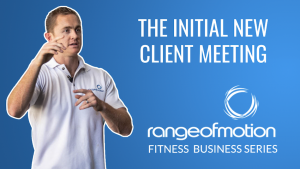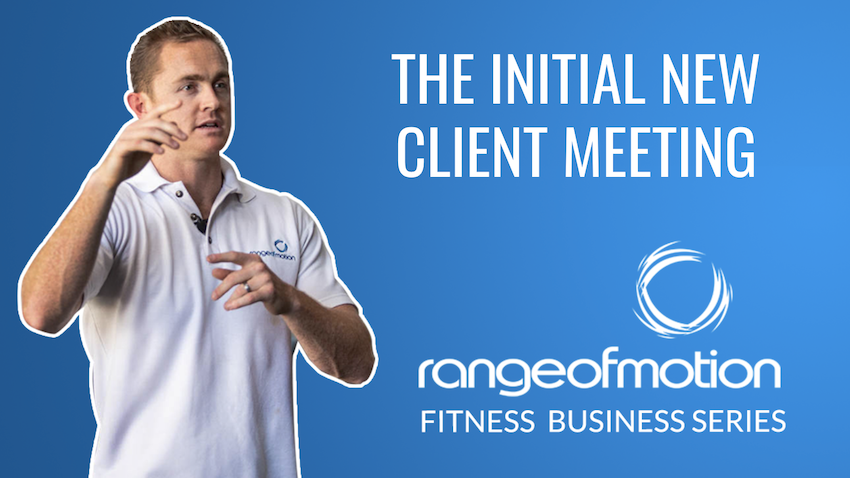Bonus Content: The Initial New Client Meeting, Range of Motion Fitness Business Series
 The days of scripts and carefully designed statements designed to influence potential clients into a sale are over.
The days of scripts and carefully designed statements designed to influence potential clients into a sale are over.
We’re marketed to hundreds of times every day. And savvy consumers have a finely tuned radar to detect all the tricks that are designed to shape their behaviour and acquire their money.
And so, when developing a process for that initial client meeting, we can strip away the rhetoric and fall back on basic human decency. We can fall back on finding the best way to genuinely help someone.
Let’s take a step back.
Why an initial sit down meeting?
It’s something we’ve always done at Range of Motion, to great effect. Over the last 18 months (at time of writing), over 95% of those people we sat down with, progressed to the next stage of our client journey.
Aside from any external marketing they may have seen, this is the first step in the face-to-face relationship between your business, and the potential client. And like any great relationship, this initial ‘date’ is, above all else, a test of whether you have a shared set of value.
Begin your chat by offering them a water, or a coffee. They’re guests in your ‘house’. Be a good host.
Your initial client meeting should NOT be a gym tour, or an exhaustive list of all the products or services you offer. It should be a conversation between two people. A conversation about your kids. About what you do for fun. About what kind of dog you have. Relationship building. Not selling. Relationship building.
It’s not uncommon for more time to be spent talking about a client’s kids or grandkids than the service you can provide them.
Because in the end, a potential future relationship isn’t about your expensive, shiny equipment, it’s about PEOPLE. We’re not in the fitness industry, we’re in the people industry.
And this conversation does one big thing. It establishes if there’s a ‘culture fit’. Is your culture one that they can see themselves being a part of? Do you see them being a good fit for you? Remember, the relationship needs to flow both ways, and there’s every chance that they may not be a good fit for your business – this doesn’t mean that there’s anything wrong with them, or with you, it just means that a partnership between the two won’t work.
In the majority of cases if you can hint at the beginnings of a future friendship, they’ll fall in love with your business long before you tell them about your classes or your creche or your pricing.
Once you’ve built a rapport, a great next step is to shift the focus to how you can help them. Remember, we’re problem solvers in the people industry. The dialogue here is absurdly simple: “So, tell me what we can do to help you?”. Then, sit back, shut up, and listen to their story. Every now and then, politely interrupt to ask questions, get more info, or pull on threads that may unravel into a clear picture of the help they need.
The purpose here is to establish what they need from you – and what you can give them. And hopefully, the two match – their needs match your offering. Sometimes this isn’t the case. And that’s fine. Again, a failed relationship is often not an indication that there was anything wrong with either party, just that the link between the parties didn’t work.
And this next bit takes some guts and some confidence. Sometimes, you need to tell them that what you do isn’t what they need. That’s right, sometimes you need to let the client know there is someone who can do a better job of helping them than you can.
And the reason this takes confidence is that all-too-often we have a fixation with our bottom line. With dollars. And often this fixation is about short-term wins. About ‘signing up the client’ today. But in the long run, if you’re not a good fit for their needs, you’re diluting their experience, and diluting your product. Dilute your product too much, and you lose your unique selling proposition (USP). Lose that, and you lose what makes you special. If you try to be everything to everyone, you end up being nothing to no one.
Fall back on your purpose. What is your purpose? Ideally, it’s not ‘to make lots of money’, but is something more akin to ‘create happy, healthy individuals’. And, as we’ve discussed, you may not be the right business to make this person happier and healthier. And that’s fine.Your job isn’t to get their money. Your job is to solve their problem. And sometimes, this problem is best solved by telling them that you’re not for them.
This works. Because ‘for profit’ organisations don’t necessarily become ‘purpose driven’ organisations. Whereas ‘for purpose’ organisations almost always increase the bottom line of that business.
If you’re brave enough to do this, you’re building the strongest LONG TERM business you possibly can.
But hopefully, their needs, and your offerings DO match. So you’ll follow up their answer to ‘how can we help you’ with a description of what you do and how you do it. And of course, how that will solve their specific problems. Make sure you emphasise your unique selling proposition here. What is it that you do differently. Note, this is NOT ‘what you do better’. It’s not a competition. It’s what you do DIFFERENTLY. In fact, you should come out and say that you don’t believe that what you do is better. You just believe it’s different – and suited to the type of person who needs (insert USP here – at Range of Motion for example, it’s ‘individualised care’).
So you’ve gone from ‘conversation mode’, into ‘listening mode’, and finally, into ‘talking mode’.
You’ll then ask them, ‘does this sound like what you’ve been looking for’. If the answer is yes, great. If the answer isn’t so positive, you need to establish if, one, you can tailor your service to suit them without deviating from your USP, or, two, whether you need to help them find somewhere that’s better suited to solve their problems.
If they feel like you can help them, this is where you become a ‘mechanic’. You see, the customer ISN’T always right. Think about when you take your car to a mechanic because there’s a weird rattling noise coming from the engine. Unless you know about cars, you’re not going to say ‘I think there’s an ignition timing issue’. You’re going to say, ‘there’s a weird ratting noise, can you please fix it’. The relationship between you and the potential client is the same. YOU are the specialist. They have come to YOU for advice.
So, give them your advice. And make sure it’s the same advice you’d give to you mum or dad or son or daughter or husband or wife or best friend. The right advice. Say something like “Ok, can I tell you what I’d recommend? Ok great, I think this is what you should do…”. Then go on to tell them about which of your services will most benefit them.
Notice there’s no sale here. You can supreme confidence in your product and you (should) believe that you have the best solution to their problems (again, if you don’t refer them to someone who does). Your are NOT a sales person. You are a PROBLEM SOLVER. This is where you outline the prices. ‘Ok, se here’s what I’d recommend. We have an option which I think will suit your needs where you can attend any three classes every week. That’s a total of $30. Does that sound like a realistic option for you?’.
If their answer is positive, you need to guide them to the next step, whatever that may be in your business. ‘Ok, can I tell you where we go from here? The next step is to…’. And the rest is history.
And one final thing. Just them being there with you is really scary. they probably felt sick with nerves as they were driving to meet you. Give them some credit for this. Show a bit of empathy. ‘Hey, hats off to you for taking this first step. I know trying something new can be a bit scary and intimidating, so well done to you for making such a positive move’.
In the end, we’re here to form relationships and solve the problems of the people who need our help.





